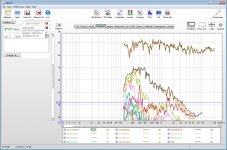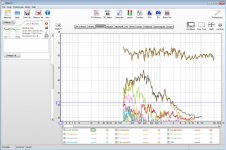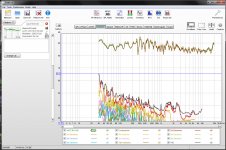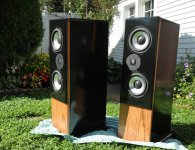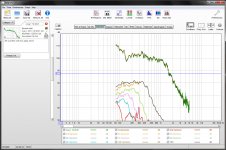I just finished building a pair of MTMs, using Zaph Audio's "Bargain Aluminum MTM" design.
This system uses Dayton DA175-8 woofers and the SEAS 27TBFC/G tweeter.
Crossover is at 1450Hz.
Testing with REW and a calibrated Dayton UMM-6 mic revealed high THD between 100 and 500Hz, tapering off above 500. Both speakers are similar. See plots (I included a shot of a measurement on another speaker I have, a Klipsch RF7-II, for comparison. It shows very low THD).
Notice that above the crossover point THD drops steeply. The tweeters, at least, seem to be on spec. Notice also that most of the distortion is odd-order. 2nd order is actually quite low.
Anyone have any idea what could be causing this distortion? Enclosure probs? Some wiring mistake in the crossover? Or are those woofers just crap? (Zaph's John Krutke thought highly of them).
Suggestions welcome!
This system uses Dayton DA175-8 woofers and the SEAS 27TBFC/G tweeter.
Crossover is at 1450Hz.
Testing with REW and a calibrated Dayton UMM-6 mic revealed high THD between 100 and 500Hz, tapering off above 500. Both speakers are similar. See plots (I included a shot of a measurement on another speaker I have, a Klipsch RF7-II, for comparison. It shows very low THD).
Notice that above the crossover point THD drops steeply. The tweeters, at least, seem to be on spec. Notice also that most of the distortion is odd-order. 2nd order is actually quite low.
Anyone have any idea what could be causing this distortion? Enclosure probs? Some wiring mistake in the crossover? Or are those woofers just crap? (Zaph's John Krutke thought highly of them).
Suggestions welcome!
Attachments
Last edited:
Certainly the distortion level seems high. Probably around 10% on the THD plot up to 400Hz. That should be noticable when listening to music.
How hard were you pushing the drivers when doing the test? At normal listening levels, or much higher? You may be pushing the drivers past their X-Max during the test...
I'm about to start up my own thread as I have a big peak in distortion at 600Hz with my MTM's, and would like to work out what might be causing that.
Just looked up the specs and x-max is 4.25mm which is pretty decent, have you modeled to see what power they should theoretically handle before exceeding x-max?
Tony.
How hard were you pushing the drivers when doing the test? At normal listening levels, or much higher? You may be pushing the drivers past their X-Max during the test...
I'm about to start up my own thread as I have a big peak in distortion at 600Hz with my MTM's, and would like to work out what might be causing that.
Just looked up the specs and x-max is 4.25mm which is pretty decent, have you modeled to see what power they should theoretically handle before exceeding x-max?
Tony.
How hard were you pushing the drivers when doing the test? At normal listening levels, or much higher? You may be pushing the drivers past their X-Max during the test...
The 85 db shown is accurate. My normal listening level. Not sure how much power that represents. Should measure it, I guess. TS specs say 50W/100W.
I'm about to start up my own thread as I have a big peak in distortion at 600Hz with my MTM's, and would like to work out what might be causing that.
What drivers are you using?
I originally planned to use the SEAS ER18RNX in these MTMs. But Zaph thought these were a good alternative, and they were 1/3 the price. May have to buy the ER18s anyway. At least the enclosure is the same.
Are these drivers in a single enclosure or divided between them?
If not, add a partition. Easy enough to do and will help. They sure look nice
No. Single compartment (xover is in separate compartment at bottom). That's what Zaph recommended.
There is evidence that when more than one driver shares an enclosure this causes interaction due to plane waves distorting the shape of the opposing cone. This effect is in both time, affecting phase/time smearing and frequency. It's about 15dB down in level.
It certainly wouldn't hurt to try my suggestion, besides if it costs you a few dollars to reduce that distortion wouldn't it be smarter than simply swapping out for drivers which will set you back hundreds?
I like John a lot, quite a few people here and elsewhere have my sincere respect. Yet also know not one person 'knows it all'.
It certainly wouldn't hurt to try my suggestion, besides if it costs you a few dollars to reduce that distortion wouldn't it be smarter than simply swapping out for drivers which will set you back hundreds?
I like John a lot, quite a few people here and elsewhere have my sincere respect. Yet also know not one person 'knows it all'.
In a symmetrical cabinet, as this appears to be, the partition will make no difference. If we had a cabinet with no stuffing we can imagine a back wave from woofer A running over to woofer B some distance away. At the same time a back wave from B runs over to A. Add a partition and the back wave from A runs to the partition and reflects or reverses course. When it comes back it is absolutely indistinguishable from the previous back wave of B.
Add proper stuffing and it becomes moot as the mid range component is easily fully absorbed.
Anyhow, distortion as shown is not related to any in-cabinet effect. If those measurements are accurate then that would be inherent in the LF drivers. Some drivers have high midrange distortion from magnetic effects. I would also be suspicious of my measurements. Are you sure there isn't filter leakage of some kind giving high distortion readings? Try measureing the amplifier output bypassing the speaker and mic. Does that measure low?
David
Add proper stuffing and it becomes moot as the mid range component is easily fully absorbed.
Anyhow, distortion as shown is not related to any in-cabinet effect. If those measurements are accurate then that would be inherent in the LF drivers. Some drivers have high midrange distortion from magnetic effects. I would also be suspicious of my measurements. Are you sure there isn't filter leakage of some kind giving high distortion readings? Try measureing the amplifier output bypassing the speaker and mic. Does that measure low?
David
The 85 db shown is accurate. My normal listening level. Not sure how much power that represents. Should measure it, I guess. TS specs say 50W/100W.
If it is actually 85db (I'm assuming at 1M) then you definitely shouldn't be exceeding xmax, and you won't be using anywhere near 50W.
Note however that driver specs are how much power the driver can handle without burning out the voice coil, not how much power they can handle without distorting. Moreover the amount of power that they can handle without distorting depends on the implementation.
Morel MW144'sWhat drivers are you using?
Something doesn't seem right. I very much doubt that one of zaph's designs would have such high distortion. Do they sound distorted when you listen to them?I originally planned to use the SEAS ER18RNX in these MTMs. But Zaph thought these were a good alternative, and they were 1/3 the price. May have to buy the ER18s anyway. At least the enclosure is the same.
Tony.
Are you sure there isn't filter leakage of some kind giving high distortion readings? Try measureing the amplifier output bypassing the speaker and mic. Does that measure low?
David
That's why I included the measurement from the Klipsch. Exact same setup (same amps, etc). It has to be in the speaker.
Something doesn't seem right. I very much doubt that one of zaph's designs would have such high distortion. Do they sound distorted when you listen to them?
Tony.
Yes. Its quite noticeable on female vocals. Of course, the distortion has be in the very band where it is most noticeable.
I agree that it is odd. No quality speaker has distortion that high in that band. I'm thinking it's some kind of odd anomaly, like something rubbing the cone, etc. But it's occurring with both speakers. Other oddities are that the FR is quite smooth (better than the Klipsches) and that the distortion is high-order. Usually 2nd order is the biggest component of THD.
Last edited:
I'm thinking it's some kind of odd anomaly, like something rubbing the cone, etc. But it's occurring with both speakers.
It could be your power amplifier is distorting. It is quite common for amplifiers' protection circuit to activate when connected to speakers with woofers in parallel.
Try testing with one woofer only or with the two woofers in series. Test it without the crossover. Amplifier direct to woofers.
In a symmetrical cabinet, as this appears to be, the partition will make no difference. If we had a cabinet with no stuffing we can imagine a back wave from woofer A running over to woofer B some distance away. At the same time a back wave from B runs over to A. Add a partition and the back wave from A runs to the partition and reflects or reverses course. When it comes back it is absolutely indistinguishable from the previous back wave of B.
Add proper stuffing and it becomes moot as the mid range component is easily fully absorbed.
Anyhow, distortion as shown is not related to any in-cabinet effect. If those measurements are accurate then that would be inherent in the LF drivers. Some drivers have high midrange distortion from magnetic effects. I would also be suspicious of my measurements. Are you sure there isn't filter leakage of some kind giving high distortion readings? Try measureing the amplifier output bypassing the speaker and mic. Does that measure low?
David
Reference: http://www.diyaudio.com/forums/multi-way/100392-beyond-ariel-306.html#post3572544
Even order could be reduced by inverting one driver, physically and electrically. Downside is the nearfield diffraction that results and lowers visual appeal (WAF). It's always a trade off.
Last edited:
Distortion peak suggests tweeter is source due to low crossover point, low order crossover, and too much signal.
Check crossover.
Measure drivers independently.
I second this
It could be your power amplifier is distorting. It is quite common for amplifiers' protection circuit to activate when connected to speakers with woofers in parallel.
Try testing with one woofer only or with the two woofers in series. Test it without the crossover. Amplifier direct to woofers.
The amp (Emotiva XPA-2) has red LEDs that light if protection is tripped. Not happening.
Testing without tweeter or xover is a good idea though. I'll try it.
Thx!
Distortion peak suggests tweeter is source due to low crossover point, low order crossover, and too much signal.
Check crossover.
Measure drivers independently.
You think the tweeter could be causing distortion at 200-400Hz? Distortion over the tweeter's range is actually very good.
Will test w/o tweeter or crossover, though.
Thx!
Following everyone's suggestions I tested the speakers w/o the tweeter or crossover (and the three drivers separately), then the system bypassing the low-pass portion of the crossover, then again with everything connected normally.
As you can see, those woofers are excellent. Smooth as can be, and THD -50db over most of their range. Photo is of the upper woofer on the left speaker, but the lower unit looks the same. Also tested the tweeter separately; it's just as good.
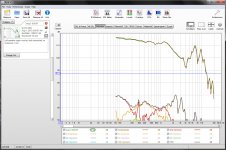
Next is the woofers with the low-pass section of the crossover bypassed, but with the tweeter connected via the high-pass circuit on the crossover. THD is still > 45 db.
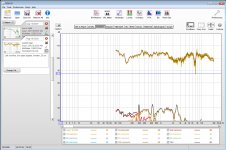
Finally, the system with the entire crossover in the circuit. THD climbs to < 20 db below 400Hz.
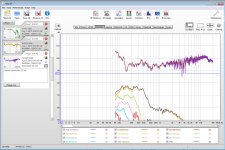
Sure looks like the low-pass filter is introducing a lot of distortion. How can that happen?
As you can see, those woofers are excellent. Smooth as can be, and THD -50db over most of their range. Photo is of the upper woofer on the left speaker, but the lower unit looks the same. Also tested the tweeter separately; it's just as good.

Next is the woofers with the low-pass section of the crossover bypassed, but with the tweeter connected via the high-pass circuit on the crossover. THD is still > 45 db.

Finally, the system with the entire crossover in the circuit. THD climbs to < 20 db below 400Hz.

Sure looks like the low-pass filter is introducing a lot of distortion. How can that happen?
- Status
- This old topic is closed. If you want to reopen this topic, contact a moderator using the "Report Post" button.
- Home
- Loudspeakers
- Multi-Way
- Distortion in MTM build
